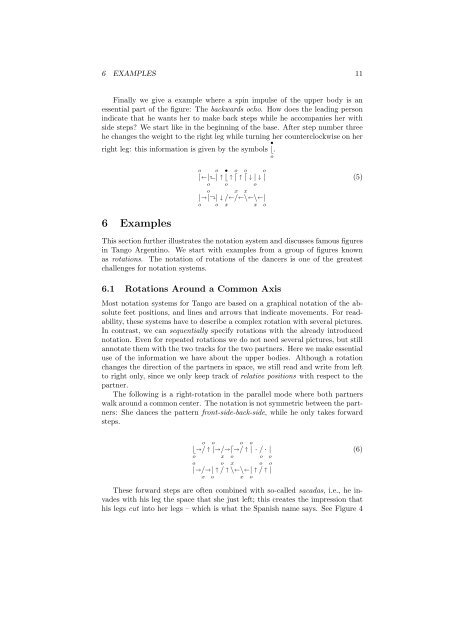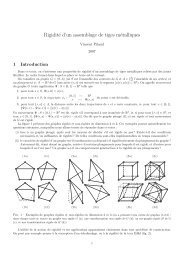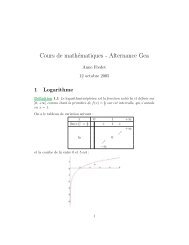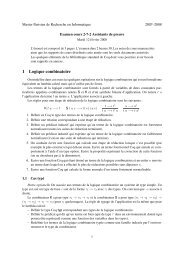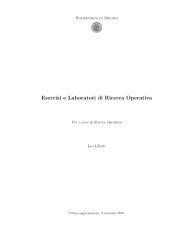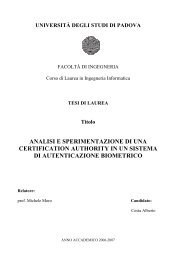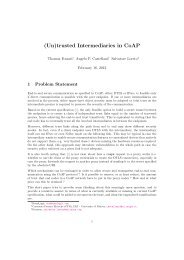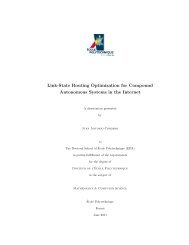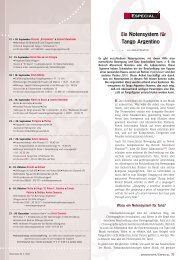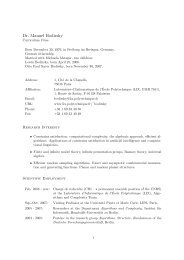You also want an ePaper? Increase the reach of your titles
YUMPU automatically turns print PDFs into web optimized ePapers that Google loves.
6 EXAMPLES 11<br />
Finally we give a example where a spin impulse of the upper body is an<br />
essential part of the figure: The backwards ocho. How does the leading person<br />
indicate that he wants her to make back steps while he accompanies her with<br />
side steps? We start like in the beginning of the base. After step number three<br />
he changes the weight to the right leg while turning her counterclockwise on her<br />
right leg: this in<strong>for</strong>mation is given by the symbols •<br />
⌊. o<br />
6 Examples<br />
o<br />
|| o<br />
| <br />
o<br />
o<br />
|<br />
| •<br />
⌊<br />
o<br />
o<br />
|<br />
o<br />
<br />
o<br />
⌈ o<br />
⌈ | <br />
o<br />
o<br />
| (5)<br />
/ <br />
x<br />
x<br />
/ x<br />
\\ |<br />
x o<br />
This section further illustrates the notation system and discusses famous figures<br />
in <strong>Tango</strong> Argentino. We start with examples from a group of figures known<br />
as rotations. The notation of rotations of the dancers is one of the greatest<br />
challenges <strong>for</strong> notation systems.<br />
6.1 Rotations Around a Common Axis<br />
Most notation systems <strong>for</strong> <strong>Tango</strong> are based on a graphical notation of the absolute<br />
feet positions, and lines and arrows that indicate movements. For readability,<br />
these systems have to describe a complex rotation with several pictures.<br />
In contrast, we can sequentially specify rotations with the already introduced<br />
notation. Even <strong>for</strong> repeated rotations we do not need several pictures, but still<br />
annotate them with the two tracks <strong>for</strong> the two partners. Here we make essential<br />
use of the in<strong>for</strong>mation we have about the upper bodies. Although a rotation<br />
changes the direction of the partners in space, we still read and write from left<br />
to right only, since we only keep track of relative positions with respect to the<br />
partner.<br />
The following is a right-rotation in the parallel mode where both partners<br />
walk around a common center. The notation is not symmetric between the partners:<br />
She dances the pattern front-side-back-side, while he only takes <strong>for</strong>ward<br />
steps.<br />
⌊ o<br />
o<br />
/ o<br />
|/ ⌈ x o<br />
o<br />
/ o<br />
| · / · |<br />
o o<br />
o<br />
|/ | <br />
x o<br />
o<br />
/ x<br />
\\ | <br />
x o<br />
o<br />
/ o<br />
|<br />
These <strong>for</strong>ward steps are often combined with so-called sacadas, i.e., he invades<br />
with his leg the space that she just left; this creates the impression that<br />
his legs cut into her legs – which is what the Spanish name says. See Figure 4<br />
(6)


